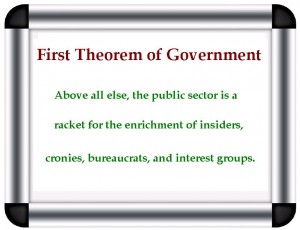How Disappointing, but how predictable.
Politicians approved legislation in 2011 that was supposed to impose a modest bit of spending restraint over the next 10 years.
It wasn’t much. The enforcement mechanism, known as sequestration, merely was supposed to guarantee that spending climbed by $2.3 trillion rather than $2.4 trillion over the 10-year period.
But something is better than nothing, and the sequester that took place this year was a bitter defeat for President Obama and other advocates of bigger government.
And it also provided comic relief as the White House engaged in hysterical rhetoric in an attempt to scare people about sequestration.
But now there’s a deal to weaken the sequester and allow more government spending over the next two years. Hatched by Paul Ryan, the Republican Chairman of the House Budget Committee, and Patty Murray, the Democrat Chairwoman of the Senate Budget Committee, the most important takeaway is that the agreement will increase spending caps by $63 billion over the next two years.
This chart shows what will happen.

he second most important thing to understand is that the Murray-Ryan deal contains several tax hikes. But since politicians can’t resist prevaricating, these provisions are being referred to as “user fees” and “offsetting receipts.”
The most outrageous tax hike is the added levy on airline travel. Honest people call this an increase in the ticket tax. The folks in Washington call it an “Aviation security service fee.”
There’s also a tax hike on private pension plans, as well as additional taxes (oops, I mean “user fees”) on trade.
You also won’t be surprised to learn that the so-called spending cuts in the agreement are mostly fluff and gimmicks.
The Treasury Department and Justice Department have been told not to spend “unobligated balances” in their forfeiture funds, but that was money they presumably weren’t going to spend anyway.
States, meanwhile, have been told they have to pay part of the cost of managing mineral leases on federal lands within their borders. Maybe someone can explain to me why payments from state governments to Washington count as a budget cuts.
And the agreement also assumes that Washington will do a better job of policing fraud in areas such as unemployment insurance and illegal utilization of handouts by prisoners. Those would be positive developments, to be sure, but one has to wonder why they weren’t enforcing those laws already.
By the way, the aforementioned tax hikes and make-believe spending cuts are supposed to generate “savings” over 10 years that will “offset” the higher spending that will occur in 2014 and 2015.
Needless to say, it’s goes without saying that all the new spending will take place in 2014 and 2015. But I wouldn’t hold my breath for alleged savings that are supposed to take effect in the following years.
 Simply stated, the ink won’t even be dry on this agreement before the lobbyists, politicians, bureaucrats, and interest groups that control Washington start maneuvering to bust the spending caps and weaken the sequester next year. And the following year. And the year after that. And…well, you can fill in the blanks.
Simply stated, the ink won’t even be dry on this agreement before the lobbyists, politicians, bureaucrats, and interest groups that control Washington start maneuvering to bust the spending caps and weaken the sequester next year. And the following year. And the year after that. And…well, you can fill in the blanks.
So what’s the bottom line?
Well, it’s clearly a big disappointment that Congressman Paul Ryan engineered this turkey of a deal rather than fighting for the sequester. Heck, this was the guy who put together very good entitlement reforms, yet now he’s helping Obama escape the sequester?
To be fair, folks on the Hill have told me that Ryan didn’t have much leverage because several Republicans indicated that they wouldn’t vote to comply with the sequester spending levels.
But if that’s the case, he should have at least forced a vote so the American people could see which GOP politicians are wobbly on the critical issue of restraining Leviathan.
To close on a somewhat optimistic note, it does appear that all the new spending is confined to 2014 and 2015. So if the spending caps are preserved for subsequent years, then it’s possible that the long-run trend line of government spending is unaffected.
That would be a good outcome. Not because the long-run trends are positive (if you look at the long-run data, we’re screwed), but because at least they wouldn’t have made a bad situation even worse.
If you want to damn the Murray-Ryan plan with faint praise, you could say it’s not nearly as bad as the read-my-lips deal of George H.W. Bush. That’s certainly true, but the sequester would be a much better outcome.

